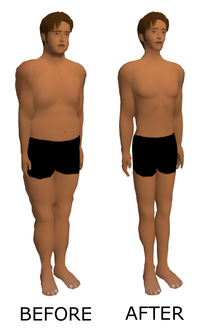
Photo from wikipedia
Background Globally, about 1.9 billion adults are overweight or obese, while 462 million are underweight. These are primarily found in countries with low and middle incomes, such as Ethiopia. Undernutrition… Click to show full abstract
Background Globally, about 1.9 billion adults are overweight or obese, while 462 million are underweight. These are primarily found in countries with low and middle incomes, such as Ethiopia. Undernutrition is a frequent health problem among people living with HIV/AIDS; however, no large-scale research, including several health facilities, has been conducted in Ethiopia. Thus, this study aimed to assess the nutritional status and nutrition-related factors among highly active antiretroviral therapy (HAART) users in public hospitals in Southwest Ethiopia. Methods A cross-sectional facility study design was conducted in all public hospitals in Southwest Ethiopia from January to March 2021. A systematic sampling technique was used to select the study participants. The collected data were entered into EpiData 3.1 and then exported to SPSS version 24 for statistical analysis. Binary logistic regression analysis was done to identify the factors associated with the outcome variable. The level of significance was declared at a P-value of <0.05, with their corresponding 95% confidence level. Results A total of 402 HAART users have participated with a 100% response rate. The proportion of undernutrition (BMI <18.5 kg/m2) and patients with overweight or obesity (BMI ≥25 kg/m2) were 29.3% [95% CI: (24.6–33.5)] and 10% [95% CI: (6.6–12.9)], respectively. Out of undernutrition patients, severe undernutrition (BMI <16 kg/m2) accounted for 5.6%. Factors, such as food insecurity [AOR: 3.21, 95% CI: (1.76–5.91)], history of diarrhea [AOR: 2.86, 95% CI: (1.96–6.78)], CD4 cell count ≤ [AOR: 4.72, 95% CI: (2.14–12.13)], and substance user [AOR: 4.12, 95% CI: (2.31–7.30)], were the independent factors of undernutrition. Conclusion This study found that the prevalence of undernutrition was high compared with other settings. The government should also pay due attention to improving the treatment of HIV/AIDS by offering nutritional support services in hospitals. Moreover, policymakers and healthcare professionals consider the effects of these factors on nutrition while providing ART services.
Journal Title: Frontiers in Nutrition
Year Published: 2022
Link to full text (if available)
Share on Social Media: Sign Up to like & get
recommendations!